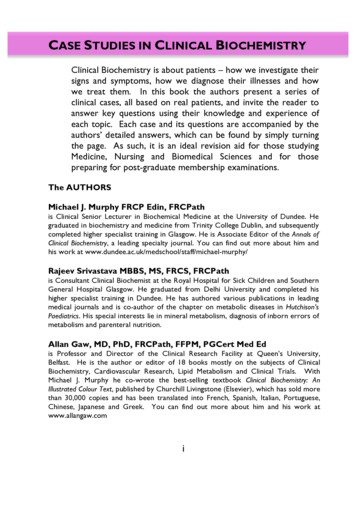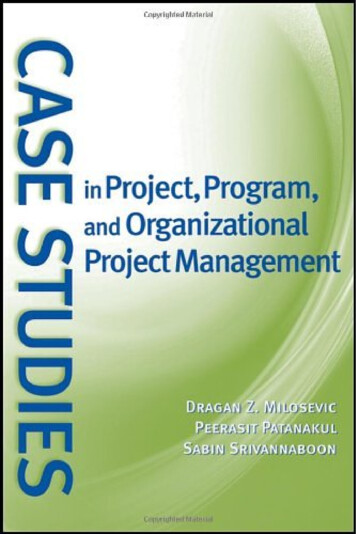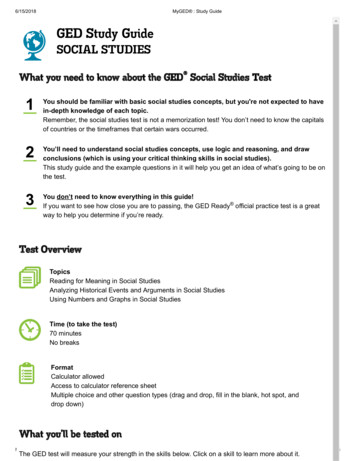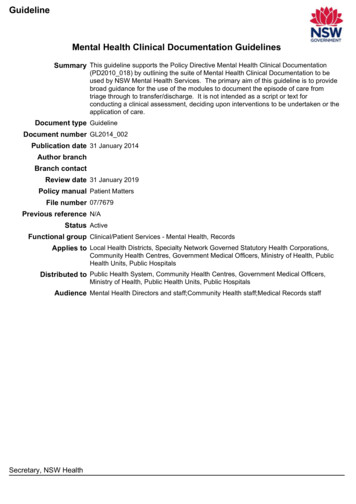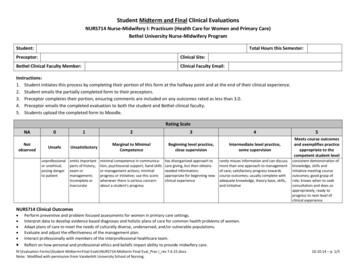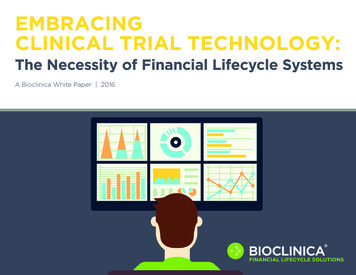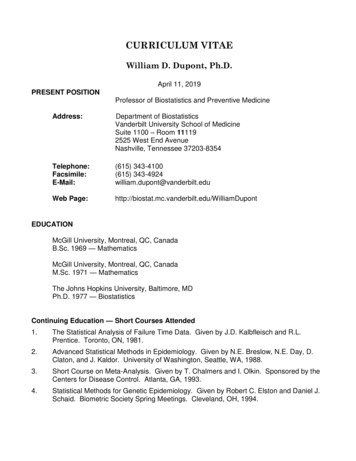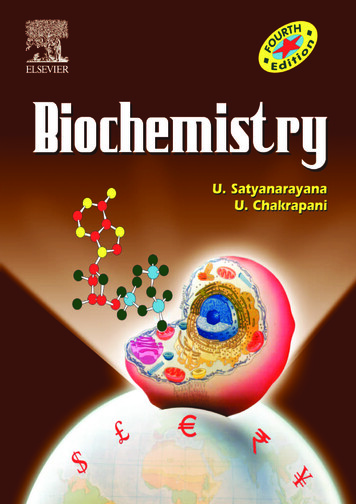
Transcription
(with Clinical Concepts & Case Studies)Dr. U. SatyanarayanaDr. U. ChakrapaniCo-published with
SECTION1
(with Clinical Concepts & Case Studies)Dr. U. SatyanarayanaM.Sc., Ph.D., F.I.C., F.A.C.B.Professor of Biochemistry & Director (Research)Dr. Pinnamaneni Siddhartha Institute of Medical Sciences(Dr. NTR University of Health Sciences)Chinaoutpalli, Gannavaram (Mdl)Krishna (Dist), A.P., IndiaDr. U. ChakrapaniM.B.B.S., M.S., D.N.B.Co-published withELSEVIERA division of Reed Elsevier India Pvt. Ltd.Since 1960Books & Allied Pvt. Ltd.
Cjpdifnjtusz-!5fSatyanarayana and ChakrapaniELSEVIERA division ofReed Elsevier India Private LimitedMosby, Saunders, Churchill Livingstone, Butterworth-Heinemann andHanley & Belfus are the Health Science imprints of Elsevier. 2013 Dr. U. SatyanarayanaFirst Published: March 1999Revised Reprint: August 2000Second Revised Edition: June 2002Revised Reprint: 2004, 2005Third Revised Edition (multicolour): 2006Revised Reprint: 2007, 2010Fourth Revised Edition: 2013All rights are reserved. No part of this publication may be reproduced, stored in a retrieval system, or transmitted in any form or byany means, electronic, mechanical, photocopying, recording, or otherwise without the prior permission of the publishers.ISBN: 978-81-312-3601-7Medical knowledge is constantly changing. As new information becomes available, changes in treatment, procedures, equipmentand the use of drugs become necessary. The author, editors, contributors and the publisher have, as far as it is possible, taken careto ensure that the information given in this text is accurate and up-to-date. However, readers are strongly advised to confirm thatthe information, especially with regard to drug dose/usage, complies with current legislation and standards of practice. Pleaseconsult full prescribing information before issuing prescriptions for any product mentioned in this publication.This edition of Biochemistry, 4e by Dr. U. Satyanarayana and Dr. U. Chakrapani is co-published by an arrangement withElsevier, a division of Reed Elsevier India Private Limited and Books and Allied (P) Ltd.ELSEVIERA division of Reed Elsevier India Private Limited.Registered Office: 305, Rohit House, 3 Tolstoy Marg, New Delhi-110 001.Corporate Office: 14th Floor, Building No. 10B, DLF Cyber City, Phase II, Gurgaon–122 002, Haryana, India.BOOKS AND ALLIED (P) Ltd.Registered Office: 8/1 Chintamoni Das Lane, Kolkata 700009.Corporate Office: No. 1-E(1) ‘Shubham Plaza’ (1st Floor), 83/1, Beliaghata Main Road, Kolkata 700 010, West Bengal, India.Cover DesignDepicts the universal energy currency of the living world—ATP, predominantly synthesized by the mitochondria of the cell(the functional unit of life), in comparison with the international currencies— , , , , .Printed and bound at .Copyright.indd i6/7/2013 4:31:26 PM
Preface to the Fourth EditionThis book ‘Biochemistry’ has undoubtedly become one of the most preferred text books (in India andmany other countries) by the students as well as teachers in medical, biological and other allied sciences.It is certainly a book of choice and a true companion to all learning biochemistry, hence appropriatelyregarded by many as ‘Bible of Biochemistry’. This book has undergone three editions, several reprints, andrevised reprints in a span of 13 years.The advances in biochemistry are evergrowing due to exponential growth of the subject. Further, thecritical comments, frank opinions and constructive suggestions by teachers and students need to beseriously considered. All this necessitates frequent revision of the book.In this fourth edition, a thorough revision and update of each chapter with latest advances has beendone. The main emphasis of this edition is an improved orientation and treatment of human biochemistryin health and disease. A wide variety of case studies with relevant biochemical profiles (along with diagnosisand discussion) are newly added as an appendix. In addition, several newer aspects of biochemistry arecovered in this edition, some of them are listed below.lllllllllllllTriacylgylcerol/fatty acid cycleMetabolic syndromeGlucose toxicityEstimated average glucosePeptide nucleic acidsPseudogenesRecombinant ribozymeslEpigenetic regulation of gene expressionMetagenomicsTherapeutic dietsAtkins dietDietary antioxidantsHigh fructose corn syrupsllllllllllllω-fatty acidSoluble and insoluble fiberTrans fatty acidsNutrigenomicsDetailed information on antivitaminsDental cariesAmino acids as neurotransmittersDisorders of membrane transportDiagnostic importance of various body fluids and tissuesEnzyme patterns in diseasesCystatin CPleural fluidHigh sensitive CRPIt is a fact that I represent a selected group of individuals authoring books, having some time atdisposal, besides hard work, determination and dedication. I consider myself as an eternal reader and aregular student of biochemistry. However, it is beyond my capability to keep track of the evergrowingadvances in biochemistry due to exponential growth of the subject. And, this makes me nervous wheneverI think of revising the book. I honestly and frankly admit that I have to depend on mature readers forsubsequent editions of this book.AN INVITATION TO READERS, WELL WISHERS AND SUBJECT EXPERTSI have to admit that it is not all the time possible for me to meet the readers individually and get theirfeedback. I sincerely invite the readers, my well wishers and experts in biochemistry subject to feel free andwrite to me (Email ID: uppalasatya@yahoo.com) expressing their frank opinions, critical comments andconstructive suggestions. And this will help me to further improve the book in subsequent revisions.Dr. U. SATYANARAYANA
Preface to the First EditionBiochemistry is perhaps the most fascinating subject as it deals with the chemical language of life, be ithuman, animal, plant or microorganism. No other science subject has as much application as biochemistry tothe disciplines of medicine, health, veterinary, agriculture bioengineering and technology. This necessitates atotally different outlook for the books on biochemistry subject.There are many biochemistry textbooks on the market. Some of them are purely basic while others areapplied, and there are very few books which cover both these aspects together. For this reason, the studentslearning biochemistry in their undergraduate courses have to depend on multiple books to acquire a soundknowledge of the subject.This book, ‘Biochemistry’ is unique with a simultaneous and equal emphasis on basic and applied aspectsof biochemistry. This textbook primarily is an integration of medical and pure sciences, comprehensively writtento meet the curriculum requirements of undergraduate courses in medical, dental, pharmacy, life-sciences andother categories (agriculture, veterinary, etc.) where students learn biochemistry as one of the subjects.The tendency among the students (particularly medical) is to regard biochemistry as being mostlyconcerned with unimportant and complicated metabolic (chemical) pathways. This book gives a new orientation to the subject of biochemistry so that the students appreciate the great importance and significance ofthe application of biochemistry to medicine.This book is designed to develop in students a sustained interest and enthusiasm to learn and develop theconcepts in biochemistry in a logical and stepwise manner. It incorporates a variety of pedagogic aids, besidescolour illustrations to help the students understand the subject quickly and to the maximum. The summaryand biomedical/clinical concepts are intended for a rapid absorption and assimilation of the facts and conceptsin biochemistry. The self-assessment exercises will stimulate the students to think rather than merely learnthe subject. In addition, these exercises (essays, short notes, fill in the blanks, multiple choice questions) setat different difficulty levels, will cater to the needs of all the categories of learners.It will not be out of place to mention here how-and when-the book was born. The entire book was writtenin the early morning hours (between 2 AM-6 AM; when the world around is fast asleep), during which periodI carry out my intellectual activities. After a sound sleep, a fresh mind packed with creative ideas and innovativethoughts, has largely helped me to write this book. My wife pleaded with me that I should not write topics likediabetes, cancer, AIDS at home. In deference to her sentiment, I made a serious attempt to write those topicsduring my leisure time in the Department. But when I went through them in my serene mood of the earlymorning hours, I had to discard them in disappointment and rewrite them. Truly, each page of this book wasconceived in darkness and born at daybreak !This textbook is a distillation of my knowledge and teaching experience in biochemistry, acquired duringthe past 25 years. It contains predigested information on biochemistry for good understanding, assimilationand reproducibility. Each page is crafted with a fine eye. The ultimate purpose of this book is to equip thereader with comprehensive knowledge in biochemistry with reference to basic as well as applied aspects.Although I have made every effort to make the book error free, I am under no illusion. I welcomecomments, criticism and suggestions from the faculty, students and other readers, and this will help me makeimprovements in the next edition.Dr. U. SATYANARAYANA[ ii ]
AcknowledgementsI owe a deep debt of gratitude to my parents, the late Sri U. Venkata Subbaiah, and Smt. Vajramma, forcultivating in me the habit of early rising. The writing of this book would never have been possible withoutthis healthy habit. I am grateful to Dr. B. S. Narasinga Rao (former Director, National Institute of Nutrition,Hyderabad) for disciplining my professional life, and to my eldest brother Dr. U. Gudaru (former Professor ofPower Systems, Walchand College of Engineering, Sangli) for disciplining my personal life.My elder son, U. Chakrapani (MBBS) deserves a special place in this book. He made a significantcontribution at every stage of its preparation—writing, verification, proof-reading and what not. I had the rareprivilege of teaching my son as he happened to be a student of our college. And a major part of this book waswritten while he was learning biochemistry. Thus, he was the first person to learn the subject of biochemistryfrom my handwritten manuscript. The student-teacher relation (rather than the father-son) has helped me inreceiving constant feedback from him and restructure the book in a way an undergraduate student wouldexpect a biochemistry textbook to be.Next, I thank Dr. G. Pitcheswara Rao (former Professor of Anatomy, SMC, Vijayawada) for his constructivecriticism and advice, and Dr. B. Sivakumar (Director, National Institute of Nutrition, Hyderabad) for his helpfulsuggestions on the microfigures.Last but not least, I thank my wife Krishna Kumari and my younger son, Amrutpani, without whosecooperation and encouragement this book could never have been written. The manuscript was carefullynurtured like a new born baby and the book has now become a full-pledged member of our family.ACKNOWLEDGEMENTS TO THE FOURTH EDITIONI am grateful to a large number of faculty members, students, friends and pen friends who directly orindirectly helped me to revise and improve the content and quality of the book. I have individually andpersonally thanked all of them (who number a few hundreds!). I once again express my gratitude to them.I thank Dr (Mrs) U.B. Vijaya Lakshmi, MD, Associate Professor of Biochemistry at our college whoparticipated to comprehensively prepare case studies with biochemical correlations, besides improving thebiomedical/ clinical aspects in some chapters. My special thanks goes to one student, and an ardent fan of mybooks, Mr. Y. Nagendra Sastry (Ph.D), who has been studying my books regularly for over 7-8 years. Hisconstant feedback and suggestions have certainly contributed to improve this book. I express my gratitude toMr. M.S.T. Jagan Mohan (my former colleague), who has helped me with his frequent interactions to revisethe book, and make it more student-friendly.I express my sincere thanks to Mr Arunabha Sen, Director, Books & Allied (P) Ltd, Kolkata for his wholehearted support and constant encouragement in revising the book, and taking all pains to bring it out to mysatisfaction. I thank Mr. Shyamal Bhattacharya for his excellent page making and graphics-work in the book.I am grateful to Mr. Abhijit Ghosal for his help in the cover design.I thank my wife, Krishna Kumari, my younger son Amrut Pani and my daughter-in law Oohasri fortheir constant support and encouragement. My special thanks to my grand daughter Maahe (2 years) whoseever smiling face, sweet words and deeds infuse energy into my academic activities. I am grateful toUppala Author-Publisher interlinks, Vijayawada for sponsoring and supporting me to bring out this edition.Dr. U. SATYANARAYANA[ iii ]
Scope of BiochemistryThe term Biochemistry was introduced by Carl Neuberg in 1903. Biochemistry broadly deals with thechemistry of life and living processes. There is no exaggeration in the statement, ‘The scope of biochemistryis as vast as life itself !’ Every aspect of life-birth, growth, reproduction, aging and death, involves biochemistry.For that matter, every movement of life is packed with hundreds of biochemical reactions. Biochemistry is themost rapidly developing and most innovative subject in medicine. This becomes evident from the fact that overthe years, the major share of Nobel Prizes earmarked for Medicine and Physiology has gone to researchersengaged in biochemistry.The discipline of biochemistry serves as a torch light to trace the intricate complexicities of biology,besides unravelling the chemical mysteries of life. Biochemical research has amply demonstrated that all livingthings are closely related at the molecular level. Thus biochemistry is the subject of unity in the diversifiedliving kingdom.Advances in biochemistry have tremendous impact on human welfare, and have largely benefited mankindand their living styles. These include the application of biochemistry in the laboratory for the diagnosis ofdiseases, the products (insulin, interferon, growth hormone etc.) obtained from genetic engineering, and thepossible use of gene therapy in the near future.Organization of the BookThis textbook, comprising 43 chapters, is organized into seven sections in the heirarchical order oflearning biochemistry.lllllllSection I deals with the chemical constituents of life—carbohydrates, lipids, proteins and amino acids,nucleic acids and enzymes.Section II physiological chemistry includes digestion and absorption, plasma proteins, hemoglobin andprophyrins, and biological oxidation.Section III incorporates all the metabolisms (carbohydrates, lipids, amino acids, nucleotides, minerals)Section IV covers hormones, organ function tests, water, electrolyte and acid-base balance, tissue proteinsand body fluids, and nutrition.Section V is exclusively devoted to molecular biology and biotechnology (DNA-replication, recombination,and repair, transcription and translation, regulation of gene expression, recombinant DNA and biotechnology)Section VI gives relevant information on current topics such as human genome project, gene therapy,bioinformatics, prostaglandins, diabetes, cancer, AIDS etc.Section VII deals with the basic aspects for learning and understanding biochemistry (bioorganicchemistry, biophysical chemistry, tools of biochemistry, genetics, immunology).Each chapter in this book is carefully crafted with colour illustrations, headings and subheadings tofacilitate quick understanding. The important applications of biochemistry to human health and disease are puttogether as biomedical/clinical concepts. Icons are used at appropriate places to serve as ‘landmarks’.The origins of biochemical words, confusables in biochemistry, practical biochemistry and clinicalbiochemistry laboratory, case studies with biochemical correlations, given in the appendix are novel features.The book is so organized as to equip the readers with a comprehensive knowledge of biochemistry.[ iv ]
ContentsSECTION ONESECTIONChemical Constituents of LifeMolecular Biology and Biotechnology24 DNA-replication, recombination and repair25 Transcription and translation26 Regulation of gene expression27 Recombinant DNA and biotechnology1234567 Biomolecules and the cell Carbohydrates39 Lipids28 Proteins and amino acids43 Nucleic acids and nucleotides69SECTION Enzymes85 Vitamins116Current28 29 30 31 32 33 34 35 36 SECTIONTWOPhysiological Biochemistry8 Digestion and absorption1659 Plasma proteins18210 Hemoglobin and porphyrins19611 Biological oxidation221SECTIONTHREEMetabolisms12 Introduction to metabolism24113 Metabolism of carbohydrates24414 Metabolism of lipids28515 Metabolism of amino acids33016 Integration of metabolism38017 Metabolism of nucleotides38718 Mineral metabolism403Human genome projectGene therapyBioinformaticsMetabolism of xenobiotics (detoxification)Prostaglandins and related compoundsBiological membranes and transportFree radicals and antioxidantsEnvironmental biochemistryInsulin, glucose homeostasis,and diabetes mellitus37 Cancer38 Acquired immunodeficiencysyndrome (AIDS)453Water, electrolyte andacid-base n function 655662Basics to Learn Biochemistry39 Introduction to bioorganic chemistry40 Overview of biophysical chemistry41 Tools of biochemistry42 Immunology43 Genetics NutritionHormones578SECTION SEVEN487FOURBiochemistry and Nutrition566Topics Tissue proteins and body fluidsSECTION523542SIXAPPENDICESAnswers to Self-assessment ExercisesI Abbreviations used in this bookII Origins of important biochemical wordsIII Common confusables in biochemistryIV Practical biochemistry—principlesV Clinical biochemistry laboratoryVI Case studies with biochemical correlationsClinical19 20 21 2223FIVE3435363738
CHEMICAL CONSTITUENTS OF LIFLIFEE1 2 3 4 5 6 7 Biomolecules and the Cell3Carbohydrates9Lipids28Proteins and Amino acids43Nucleic acids and Nucleotides 69Enzymes85Vitamins116SectionI
“This page intentionally left blank"
Section 1Chemical Constituents of LifeChapterBiomolecules and the Cell1The cell speaks :“I am the unit of biological activity;Organized into subcellular organelles;Assigned to each are specific duties;Thus, I truly represent life!”Torganic compounds. It is believed that man maycontain about 100,000 different types ofmolecules although only a few of them havebeen characterized.he living matter is composed of mainlysix elements—carbon, hydrogen, oxygen,nitrogen, phosphorus and sulfur. These elementstogether constitute about 90% of the dry weightof the human body. Several other functionallyimportant elements are also found in the cells.These include Ca, K, Na, Cl, Mg, Fe, Cu, Co, I,Zn, F, Mo and Se.Complex biomoleculesThe organic compounds such as amino acids,nucleotides and monosaccharides serve as themonomeric units or building blocks of complexbiomolecules—proteins, nucleic acids (DNA andRNA) and polysaccharides, respectively. Theimportant biomolecules (macromolecules) withtheir respective building blocks and majorfunctions are given in Table 1.1. As regardslipids, it may be noted that they are notbiopolymers in a strict sense, but majority ofthem contain fatty acids.Carbon—a unique element of lifeCarbon is the most predominant and versatileelement of life. It possesses a unique property toform infinite number of compounds. This isattributed to the ability of carbon to form stablecovalent bonds and C C chains of unlimitedlength. It is estimated that about 90% ofcompounds found in living system invariablycontain carbon.Structural heirarchy of an organismThe macromolecules (proteins, lipids, nucleicacids and polysaccharides) form supramolecularassemblies (e.g. membranes) which in turnorganize into organelles, cells, tissues, organsand finally the whole organism.Chemical molecules of lifeLife is composed of lifeless chemicalmolecules. A single cell of the bacterium,Escherichia coli contains about 6,000 different3
4BIOCHEMISTRYTABLE 1.1 The major complex biomolecules of cellsBiomoleculeBuilding block(repeating unit)Major functions1. ProteinAmino acidsFundamental basis of structure andfunction of cell (static and dynamic functions).2. Deoxyribonucleic acid (DNA)DeoxyribonucleotidesRepository of hereditary information.3. Ribonucleic acid (RNA)RibonucleotidesEssentially required for protein biosynthesis.4. Polysaccharide (glycogen)Monosaccharides (glucose)Storage form of energy to meet short termdemands.5. LipidFatty acids, glycerolStorage form of energy to meet long termdemands; structural components of membranes.Chemical composition of manProkaryotic and eukaryotic cellsThe chemical composition of a normal man,weighing 65 kg, is given in Table 1.2. Water isthe solvent of life and contributes to more than60% of the weight. This is followed by protein(mostly in muscle) and lipid (mostly in adiposetissue). The carbohydrate content is rather lowwhich is in the form of glycogen.The cells of the living kingdom may bedivided into two categoriesTHE CELLThe cell is the structural and functional unitof life. It may be also regarded as the basic unitof biological activity.The concept of cell originated from thecontributions of Schleiden and Schwann (1838).However, it was only after 1940, thecomplexities of cell structure were exposed.TABLE 1.2 Chemical composition of a normal man(weight 65 kg)ConstituentPercent (%)Weight 1.51Minerals6.141. Prokaryotes (Greek : pro – before; karyon –nucleus) lack a well defined nucleus and possessrelatively simple structure. These include thevarious bacteria.2. Eukaryotes (Greek : eu – true; karyon –nucleus) possess a well defined nucleus and aremore complex in their structure and function.The higher organisms (animals and plants) arecomposed of eukaryotic cells.A comparison of the characteristics betweenprokaryotes and eukaryotes is listed in Table 1.3.EUKARYOTIC CELLThe human body is composed of about 1014cells. There are about 250 types of specializedcells in the human body e.g. erythrocytes,nerve cells, muscle cells, E cells of pancreas.An eukaryotic cell is generally 10 to 100 Pmin diameter. A diagrammatic representationof a typical rat liver cell is depicted inFig.1.1.The plant cell differs from an animal cell bypossessing a rigid cell wall (mostly composed ofcellulose) and chloroplasts. The latter are thesites of photosynthesis.
5Chapter 1 : BIOMOLECULES AND THE CELLTABLE 1.3 Comparison between prokaryotic and eukaryotic cellsCharacteristicProkaryotic cellEukaryotic cellSmall (generally 1-10 Pm)Large (generally 10-100 Pm)2. Cell membraneCell is enveloped by a rigid cell wallCell is enveloped by a flexible plasma membrane3. Sub-cellularorganellesAbsentDistinct organelles are found(e.g. mitochondria, nucleus, lysosomes)4. NucleusNot well defined; DNA is foundas nucleoid, histones are absentNucleus is well defined, surrounded by amembrane; DNA is associated with histones5. Energy metabolismMitochondria absent, enzymes ofenergy metabolism bound tomembraneEnzymes of energy metabolism are locatedin mitochondria6. Cell divisionUsually fission and no mitosisMitosis7. CytoplasmOrganelles and cytoskeletonabsentContains organelles and cytoskeleton(a network of tubules and filaments)1. SizeThe cell consists of well defined subcellularorganelles, enveloped by a plasma enate, it is possible to isolate eachcellular organelle in a relatively pure form(Refer Chapter 41). The distribution of majorenzymes and metabolic pathways in differentcellular organelles is given in the chapteron enzymes (Refer Fig.6.6). The subcellularorganelles are briefly described in the followingpages.NucleusNucleus is the largest cellular organelle,surrounded by a double membrane nuclearenvelope. The outer membrane is continuouswith the membranes of endoplasmic reticulum.At certain intervals, the two nuclear membraneshave nuclear pores with a diameter of about 90nm. These pores permit the free passage of theproducts synthesized in the nucleus into thesurrounding cytoplasm.MitochondrionPlasma membraneVacuoleRough endoplasmic reticulumRibosomesGolgi apparatusNucleusNucleolusSmooth endoplasmic ed pitsFig. 1.1 : Diagrammatic representation of a rat liver cell.
6Nucleus contains DNA, the repository ofgenetic information. Eukaryotic DNA isassociated with basic protein (histones) in theratio of 1 : 1, to form nucleosomes. An assemblyof nucleosomes constitutes chromatin fibres ofchromosomes (Greek: chroma – colour; soma –body). Thus, a single human chromosome iscomposed of about a million nucleosomes. Thenumber of chromosomes is a characteristicfeature of the species. Humans have 46chromosomes, compactly packed in the nucleus.The nucleus of the eukaryotic cell contains adense body known as nucleolus. It is rich inRNA, particularly the ribosomal RNA whichenters the cytosol through nuclear pores.The ground material of the nucleus is oftenreferred to as nucleoplasm. It is rich in enzymessuch as DNA polymerases and RNA S) is a rare condition of aging beginning atbirth (incidence I in 5 million births). HGPSoccurs as a result of distortion of nuclearenvelope due to accumulation of abnormalprotein namely lamina A.MitochondriaThe mitochondria (Greek: mitos – thread;chondros – granule) are the centres for thecellular respiration and energy metabolism. Theyare regarded as the power houses of the cellwith variable size and shape. Mitochondria arerod-like or filamentous bodies, usually withdimensions of 1.0 u 3 Pm. About 2,000mitochondria, occupying about 1/5th of the totalcell volume, are present in a typical cell.The mitochondria are composed of a doublemembrane system (Refer Fig.11.5). The outermembrane is smooth and completely envelopsthe organelle. The inner membrane is folded toform cristae (Latin – crests) which occupy alarger surface area. The internal chamber ofmitochondria is referred to as matrix or mitosol.The components of electron transport chainand oxidative phosphorylation (flavoprotein,cytochromes b, c1, c, a and a3 and couplingfactors) are buried in the inner mitochondrialmembrane. The matrix contains several enzymesconcerned with the energy metabolism ofBIOCHEMISTRYcarbohydrates, lipids and amino acids (e.g., citricacid cycle, E-oxidation). The matrix enzymesalso participate in the synthesis of heme andurea. Mitochondria are the principal producersof ATP in the aerobic cells. ATP, the energycurrency, generated in mitochondria is exportedto all parts of the cell to provide energy for thecellular work.The mitochondrial matrix contains a circulardouble stranded DNA (mtDNA), RNA andribosomes. Thus, the mitochondria are equippedwith an independent protein synthesizingmachinery. It is estimated that about 10% of themitochondrial proteins are produced in themitochondria.The structure and functions of mitochondriaclosely resemble prokaryotic cells. It ishypothesized that mitochondria have evolvedfrom aerobic bacteria. Further, it is believed thatduring evolution, the aerobic bacteria developeda symbiotic relationship with primordialanaerobic eukaryotic cells that ultimately led tothe arrival of aerobic eukaryotes.Endoplasmic reticulumThe network of membrane enclosed spacesthat extends throughout the cytoplasmconstitutes endoplasmic reticulum (ER). Some ofthese thread-like structures extend from thenuclear pores to the plasma membrane.A large portion of the ER is studded withribosomes to give a granular appearance whichis referred to as rough endoplasmic reticulum.Ribosomes are the factories of proteinbiosynthesis. During the process of cellfractionation, rough ER is disrupted to form smallvesicles known as microsomes. It may be notedthat microsomes as such do not occur in the cell.The smooth endoplasmic reticulum does notcontain ribosomes. It is involved in the synthesisof lipids (triacylglycerols, phospholipids, sterols)and metabolism of drugs, besides supplying Ca2 for the cellular functions.Golgi apparatusEukaryotic cells contain a unique cluster ofmembrane vesicles known as dictyosomes
7Chapter 1 : BIOMOLECULES AND THE CELLwhich, in turn, constitute Golgi apparatus (orGolgi complex). The newly synthesized proteinsare handed over to the Golgi apparatus whichcatalyse the addition of carbohydrates, lipids orsulfate moieties to the proteins. These chemicalmodifications are necessary for the transport ofproteins across the plasma membrane.Certain proteins and enzymes are enclosed inmembrane vesicles of Golgi apparatus andsecreted from the cell after the appropriatesignals. The digestive enzymes of pancreas areproduced in this fashion.Golgi apparatus are also involved in themembrane synthesis, particularly for theformation of intracellular organelles (e.g.peroxisomes, lysosomes).LysosomesLysosomes are spherical vesicles envelopedby a single membrane. Lysosomes are regardedas the digestive tract of the cell, since they areactively involved in digestion of cellularsubstances—namely proteins, lipids, carbohydrates and nucleic acids. Lysosomal enzymesare categorized as hydrolases. These includethe enzymes (with substrate in brackets)—D-glucosidase (glycogen), cathepsins (proteins),lipases (lipids), ribonucleases (RNA).The lysosomal enzymes are responsible formaintaining the cellular compounds in a dynamicstate, by their degradation and recycling. Thedegraded products leave the lysosomes, usuallyby diffusion, for reutilization by the cell.Sometimes, however, certain residual pr
The tendency among the students (particularly medical) is to regard biochemistry as being mostly concerned with unimportant and complicated metabolic (chemical) pathways. This book gives a new orienta-tion to the subject of biochemistry so that the students

